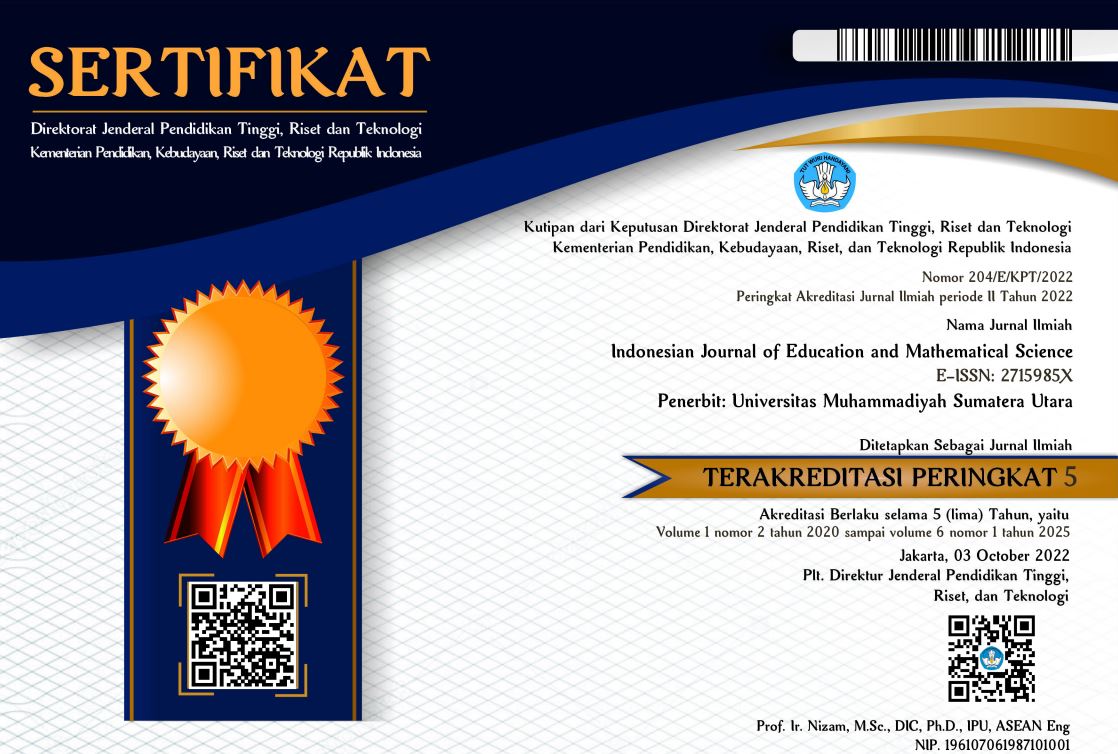Effect of Implementation of Attention Relevance Confidence Satisfaction Learning Model on Interests and Learning Outcomes of Students on Quadrilateral Materials
Abstract
Keywords
Full Text:
PDFReferences
Achru, A. (2019). Pengembangan Minat Belajar Dalam Pembelajaran. Idaarah: Jurnal Manajemen Pendidikan, 3(2), 205. https://doi.org/10.24252/idaarah.v3i2.10012
Ayuningtyas, V., Fathurrohman, M., Anriani, N., & Nisiyatussani. (2018). Geogebra Applets Design and Development for Junior High School Students To Learn Quadrilateral Mathematics Concepts. Journal on Mathematics Education, 9(1), 27–40.
Fidyawati, D., Musa, L. A. D., & Yusuf, M. (2022). Pengembangan Lembar Kerja Siswa dengan Pendekatan Kontekstual Pada Materi Segi Empat dan Segitiga. Al-Khwarizmi: Jurnal Pendidikan Matematika Dan Ilmu Pengetahuan Alam, 10(2), 95–110.
Jamil, M. M. (2019). Optimalisasi Model ARCS Dalam Pembelajaran Saintifik Untuk Meningkatkan Motivasi Belajar Peserta Didik Pada Peminatan Mata Optimization of the ARCS Model in Scientific Learning to Improve Learning Motivation of Students in Specialization in Geography in M. Indonesian Journal of Science Education, 1(1), 7–24.
Keller, J. M. (1987). Development and use of the ARCS model of instructional design. Journal of Instructional Development, 10(3), 2–10. https://doi.org/10.1007/BF02905780
Mayzhurra, B., & Hariyono, E. (2021). Analisis Minat dan Motivasi Belajar Peserta Didik Kelas XI Pada Materi Gelombang Dimasa Pandemi Covid -19. IPF: Inovasi Pendidikan Fisika, 10(2), 28–38. https://doi.org/10.26740/ipf.v10n2.p28-38
Nurhasanah, S., & Sobandi, A. (2016). Minat Belajar Sebagai Determinan Hasil Belajar Siswa. Jurnal Pendidikan Manajemen Perkantoran, 1(1), 128. https://doi.org/10.17509/jpm.v1i1.3264
Putri, F., Yerizon, & Yurnalis. (2023). The development of module based on ARCS (attention, relevance, confidence, satisfaction) in number materials at grade VII junior high school/MTS. AIP Conference Proceedings, 2698(1), 60037. https://doi.org/10.1063/5.0122478
Rahma, N. A., & Nurhalimah, W. (2022). Solving the Limits of Algebraic Functions using the Guided Inquiry Learning Approach. Transcendent Journal of Mathematics and Application, 1(1), 11–18.
Rukminingsih, Adnan, G., & Latief, M. A. (2020). Metode Penelitian Pendidikan: Penelitian Kuantitatif, Penelitian Kualitatif, Penelitian Tindakan Kelas. Erhaka Utama.
Shalihah, N. F., Wibowo, T., & Yuzianah, D. (2022). Development of open-ended-based mathematics e-module on quadrilateral material of junior high school. JTAM (Jurnal Teori Dan Aplikasi Matematika), 6(2), 331–340.
Sofian, S. (2014). Metode Penelitian Kuantitatif: Dilengkapi Perbandingan Perhitungan Manual dan SPSS. Jakarta: KencanaPrenada Media Group.
Stefany, E. M. (2016). Pengaruh Strategi Arcs (Attention, Relevance, Confidence and Satisfaction) Terhadap Motivasi Belajar Tik Siswa Di Smp 4 Negara. Edutic - Scientific Journal of Informatics Education, 1(2), 1–8. https://doi.org/10.21107/edutic.v1i2.1549
Stefany Maya, E. (2014). Pengaruh strategi arcs (Attention, Relevance, Confidence, and Satisfaction) Terhadap Motivasi Dan Hasil Belajar TIK Siswa Kelas VIII DI SMP Negeri 4 Negara. E-Journal Program Pascasarjana Universitas Pendidikan Ganesha Progam Sudi Teknologi Pembelajaran, 4, 1–9.
Sugiyono. (2013). Metode Penelitian Administrasi. Alfabeta.
Sugiyono, P. (2011). Metodologi penelitian kuantitatif kualitatif dan R&D. Alpabeta, Bandung, 62–70.
Sundari, W., & Siahaan, S. M. (2023). Digital Teaching Materials Based on Attention Relevance Confidence Satisfaction Substance Pressure Material. Journal of Curriculum Indonesia, 6(1), 69–75.
Susanti, L. (2018). Implementasi Motivasi Belajar Model ARCS (Attention, Relevence, Confidence, Satisfaction) Siswa Kelas XI Di SMA Charis Malang. UPH Press.
DOI: https://doi.org/10.30596/ijems.v4i2.14576
Refbacks
- There are currently no refbacks.
Indonesian Journal of Education and Mathematics Science
Universitas Muhammadiyah Sumatera Utara
Kampus Utama
Jl. Kapten Muchtar Basri No.3, Glugur Darat II,Medan
Sumatera Utara-20238
E-mail: ijems@umsu.ac.id
This work is licensed under a Creative Commons Attribution-ShareAlike 4.0 International License.






